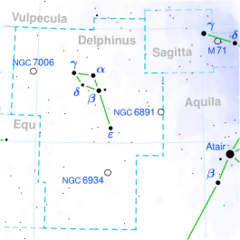Astronomy:Rho Aquilae
| Observation data Equinox J2000.0]] (ICRS) | |
|---|---|
| Constellation | Delphinus |
| Right ascension | 20h 14m 16.61886s[1] |
| Declination | +15° 11′ 51.3923″[1] |
| Apparent magnitude (V) | 4.94[2] |
| Characteristics | |
| Spectral type | A2 V[3] |
| U−B color index | +0.01[4] |
| B−V color index | +0.09[4] |
| Astrometry | |
| Radial velocity (Rv) | −23.0[2] km/s |
| Proper motion (μ) | RA: +55.03[1] mas/yr Dec.: +58.14[1] mas/yr |
| Parallax (π) | 21.75 ± 0.26[1] mas |
| Distance | 150 ± 2 ly (46.0 ± 0.5 pc) |
| Absolute magnitude (MV) | +1.63[5] |
| Details | |
| Mass | 1.94±0.04[6] M☉ |
| Radius | 1.95[7] R☉ |
| Luminosity | 22[6] L☉ |
| Surface gravity (log g) | 4.2[7] cgs |
| Temperature | 8,900±100[6] K |
| Metallicity [Fe/H] | −0.21[8] dex |
| Rotational velocity (v sin i) | 180[9] km/s |
| Age | 300±100[6] Myr |
| Other designations | |
| Database references | |
| SIMBAD | data |
Rho Aquilae, ρ Aquilae, is the Bayer designation for a star in the northern constellation of Delphinus. It has an apparent visual magnitude of 4.94[2] and is bright enough to be seen with the naked eye in good conditions.
Distance, proper motion and constellation
The annual parallax shift is 21.75 milliarcseconds,[1] which corresponds to a distance of the star of around 150 light-years (46 parsecs) from Earth. Relatively high proper motion resulted in the star crossing the border from Aquila into Delphinus in 1992.[11][12] Rho Aquilae is therefore a rare occurrence of a mismatch between current constellation and Bayer designation constellation. The star is in the low-northern constellation of Delphinus therefore at least seasonally visible to all but the high southern latitudes.
Chinese constellations and components
This star has the traditional name Tso Ke, from the Cantonese 左旗 jo keih meaning "the left flag". In Chinese, 左旗 (Zuǒ Qí in Mandarin), within the Ox, refers to an asterism consisting of this star, α, β, γ, δ, ζ, 11, 13, and 14 Sagittae stars of Sagitta to the west.[13] Consequently, ρ Aquilae itself is known as 左旗九 (Zuǒ Qí jiǔ, English: the Ninth Star of Left Flag.)[14]
Physical characteristics
Rho Aquilae is an A-type main sequence star with a stellar classification of A2 V.[3] This star is about 400 million years old and it displays an excess emission of infrared radiation that may be explained by a circumstellar disk of dust.[15][16]
References
- ↑ 1.0 1.1 1.2 1.3 1.4 1.5 van Leeuwen, F. (November 2007), "Validation of the new Hipparcos reduction", Astronomy and Astrophysics 474 (2): 653–664, doi:10.1051/0004-6361:20078357, Bibcode: 2007A&A...474..653V.
- ↑ 2.0 2.1 2.2 Wielen, R. et al. (1999), "Sixth Catalogue of Fundamental Stars (FK6). Part I. Basic fundamental stars with direct solutions", Veroeffentlichungen des Astronomischen Rechen-Instituts Heidelberg (Astronomisches Rechen-Institut Heidelberg) 35 (35): 1, Bibcode: 1999VeARI..35....1W.
- ↑ 3.0 3.1 Cowley, A. et al. (April 1969), "A study of the bright A stars. I. A catalogue of spectral classifications", Astronomical Journal 74: 375–406, doi:10.1086/110819, Bibcode: 1969AJ.....74..375C.
- ↑ 4.0 4.1 Johnson, H. L. et al. (1966), "UBVRIJKL photometry of the bright stars", Communications of the Lunar and Planetary Laboratory 4 (99): 99, Bibcode: 1966CoLPL...4...99J.
- ↑ Anderson, E.; Francis, Ch. (2012), "XHIP: An extended hipparcos compilation", Astronomy Letters 38 (5): 331, doi:10.1134/S1063773712050015, Bibcode: 2012AstL...38..331A.
- ↑ 6.0 6.1 6.2 6.3 Pearce, Tim D.; Launhardt, Ralf; Ostermann, Robert; Kennedy, Grant M.; Gennaro, Mario; Booth, Mark; Krivov, Alexander V.; Cugno, Gabriele et al. (2022), "Planet populations inferred from debris discs. Insights from 178 debris systems in the ISPY, LEECH, and LIStEN planet-hunting surveys", Astronomy and Astrophysics 659, doi:10.1051/0004-6361/202142720, Bibcode: 2022A&A...659A.135P.
- ↑ 7.0 7.1 Stassun, Keivan G. et al. (2019-10-01), "The Revised TESS Input Catalog and Candidate Target List", The Astronomical Journal 158 (4): 138, doi:10.3847/1538-3881/ab3467, ISSN 0004-6256, Bibcode: 2019AJ....158..138S.
- ↑ Anders, F.; Khalatyan, A.; Chiappini, C.; Queiroz, A. B.; Santiago, B. X.; Jordi, C.; Girardi, L.; Brown, A. G. A. et al. (1 August 2019), "Photo-astrometric distances, extinctions, and astrophysical parameters for Gaia DR2 stars brighter than G = 18", Astronomy and Astrophysics 628: A94, doi:10.1051/0004-6361/201935765, ISSN 0004-6361, Bibcode: 2019A&A...628A..94A.
- ↑ Royer, F.; Zorec, J.; Gómez, A. E. (February 2007), "Rotational velocities of A-type stars. III. Velocity distributions", Astronomy and Astrophysics 463 (2): 671–682, doi:10.1051/0004-6361:20065224, Bibcode: 2007A&A...463..671R.
- ↑ "* rho Aql". SIMBAD. Centre de données astronomiques de Strasbourg. http://simbad.u-strasbg.fr/simbad/sim-basic?Ident=%2A+rho+Aql.
- ↑ Hirshfeld, A. et al. (August 1992), "Book-Review - Sky Catalogue 2000.0 - V.1 - Stars to Magnitude 8.0 ED.2", Journal of the Royal Astronomical Society of Canada 86 (4): 221, Bibcode: 1992JRASC..86..221L
- ↑ Patrick Moore (29 June 2013). The Observer's Year: 366 Nights of the Universe. Springer Science & Business Media. pp. 132–. ISBN 978-1-4471-3613-2. https://books.google.com/books?id=p87TBwAAQBAJ&pg=PA132.
- ↑ (in Chinese) 中國星座神話, written by 陳久金. Published by 台灣書房出版有限公司, 2005, ISBN:978-986-7332-25-7.
- ↑ (in Chinese) AEEA (Activities of Exhibition and Education in Astronomy) 天文教育資訊網 2006 年 7 月 3 日
- ↑
- ↑ Morales, Farisa Y. et al. (April 2011), "Common Warm Dust Temperatures Around Main-sequence Stars", The Astrophysical Journal Letters 730 (2): L29, doi:10.1088/2041-8205/730/2/L29, Bibcode: 2011ApJ...730L..29M, https://authors.library.caltech.edu/24736/.
External links
- Simbad
- Image
- HR 7724
- Kaler, Jim. "Rho Aquilae". University of Illinois at Urbana-Champaign. http://stars.astro.illinois.edu/sow/rhoaql.html. Retrieved 2009-07-12.
 |


